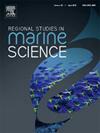Seomjin河口和光阳湾浮游动物群落的时空动态研究:序列分配物种(SAS)和形态物种鉴定(MSI)的比较分析
IF 2.1
4区 环境科学与生态学
Q3 ECOLOGY
引用次数: 0
摘要
河口和海岸生态系统是动态环境,具有很强的环境梯度,影响着浮游动物群落的结构和分布。了解这些模式对生态系统管理和生物多样性评价至关重要;然而,我们的比较分析表明,传统的形态鉴定一直低估了物种多样性。采用序列分配物种(SAS)和形态物种鉴定(MSI)方法,研究了Seomjin河口和光阳湾沿河口-海洋梯度的浮游动物群落结构和桡足类物种分布。我们于2023年5月和9月采集了6个站点的环境变量和浮游动物样本。桡足类占浮游动物群落的55.1% %,纤毛虫占31.6% %,浮游动物占8.2% %,其他动物占5.0% %。SAS分析显示,共有31种桡足动物分布在3目中,相似性值为97.03 % ~ 99.29 %。群落结构和多样性指数存在明显的时空差异。5月桡足类丰度显著增加,特别是在海湾站,而9月分布较为均匀。环境分析表明,盐度和水温是物种分布的主要驱动因素,导致河口和海湾环境的物种组成不同。物种多样性(H′)在SAS(0.69 ~ 2.92)高于MSI(0.47 ~ 1.74),均表明5月份物种多样性有所增加。NMDS分析显示,河口与海湾群落存在明显的空间分离,表明环境变量对群落结构的影响。这一发现提高了我们对过渡水域浮游动物生态学的认识。这两种方法都提供了有价值的见解;而SAS在复杂河口生态系统中具有较高的准确率、较高的检出率、更明显的群落差异和更强的环境相关性,表明其在复杂河口生态系统中具有更好的生物多样性评价效果。本文章由计算机程序翻译,如有差异,请以英文原文为准。
Exploring the spatial and temporal dynamics of zooplankton assemblages in the Seomjin estuary and Gwangyang Bay, South Korea: A comparative analysis of Sequence Assignments Species (SAS) and Morphological Species Identification (MSI)
Estuarine and coastal ecosystems are dynamic environments with strong environmental gradients that influence zooplankton community structure and distribution. Comprehending these patterns is essential for ecosystem management and biodiversity evaluation; however, traditional morphological identification consistently underestimates species diversity, as demonstrated by our comparative analysis. This research examined the structure of zooplankton communities and the distribution of copepod species along an estuarine-marine gradient in the Seomjin estuary and Gwangyang Bay, employing both Sequence Assignments Species (SAS) and Morphological Species Identification (MSI) methodologies. We collected environmental variables and zooplankton samples from six stations in May and September 2023. The Copepoda group constituted 55.1 % of the zooplankton community, with Ciliophora at 31.6 %, Meroplankton at 8.3 %, and Others at 5.0 %. SAS analysis revealed the presence of 31 copepod species distributed among three orders, exhibiting similarity values between 97.03 % and 99.29 %. We observed strong spatial and temporal variations in community structure and diversity indices. Copepod abundance significantly increased in May, especially at bay stations, whereas September showed more uniform distribution. Environmental analysis revealed that salinity and water temperature were primary drivers of species distribution, resulting in distinct species composition between estuarine and bay environments. Species diversity (H′) was consistently greater in SAS (0.69–2.92) than in MSI (0.47–1.74), with both methods indicating elevated diversity in May. NMDS analysis revealed distinct spatial separation between estuarine and bay communities, indicating the impact of environmental variables on community structure. The findings improve our understanding of zooplankton ecology in transitional waters. Both methods offer valuable insights; however, SAS consistently exhibited greater accuracy, evidenced by higher detection rates, more apparent community differences, and stronger environmental correlation, indicates its better performance for biodiversity assessment in complex estuarine ecosystems.
求助全文
通过发布文献求助,成功后即可免费获取论文全文。
去求助
来源期刊

Regional Studies in Marine Science
Agricultural and Biological Sciences-Ecology, Evolution, Behavior and Systematics
CiteScore
3.90
自引率
4.80%
发文量
336
审稿时长
69 days
期刊介绍:
REGIONAL STUDIES IN MARINE SCIENCE will publish scientifically sound papers on regional aspects of maritime and marine resources in estuaries, coastal zones, continental shelf, the seas and oceans.
 求助内容:
求助内容: 应助结果提醒方式:
应助结果提醒方式:


